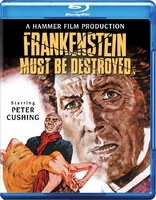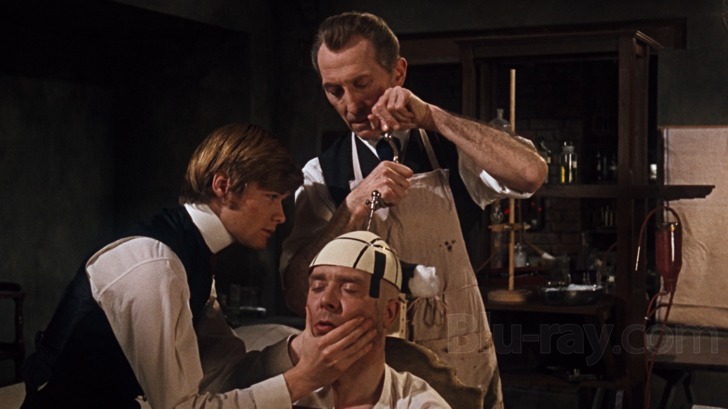Frankenstein Must Be Destroyed Blu-ray Movie
HomeFrankenstein Must Be Destroyed Blu-ray Movie 
Warner Bros. | 1969 | 101 min | Rated PG-13 | Oct 06, 2015
Movie rating
7.2 | / 10 |
Blu-ray rating
| Users | 0.0 | |
| Reviewer | 3.5 | |
| Overall | 3.5 |
Overview
Frankenstein Must Be Destroyed (1969)
Baron Frankenstein travels to a new town to meet Dr. Brandt, with whom he had hoped to collaborate. When he learns that Brandt is in a mental asylum he takes a room in a boarding house run by Anna, whose fiance, Karl, is a doctor who works at the asylum. Blackmailing Anna and Karl into helping him, Frankenstein kidnaps Brandt to learn his secrets.
Starring: Peter Cushing, Veronica Carlson, Freddie Jones, Simon Ward, Thorley WaltersDirector: Terence Fisher
| Horror | 100% |
| Sci-Fi | Insignificant |
| Drama | Insignificant |
Specifications
Video
Video codec: MPEG-4 AVC
Video resolution: 1080p
Aspect ratio: 1.78:1
Original aspect ratio: 1.85:1
Audio
English: DTS-HD Master Audio Mono (48kHz, 24-bit)
French: Dolby Digital Mono
Spanish: Dolby Digital Mono
Spanish: Dolby Digital Mono (Spain)
Subtitles
English SDH, French, Japanese, Spanish
Discs
50GB Blu-ray Disc
Single disc (1 BD)
Playback
Region free
Review
Rating summary
| Movie | 3.5 | |
| Video | 4.0 | |
| Audio | 3.5 | |
| Extras | 0.5 | |
| Overall | 3.5 |
Frankenstein Must Be Destroyed Blu-ray Movie Review
He's Alive! Still Alive!
Reviewed by Michael Reuben October 9, 2015From Hammer Horror's Frankenstein series, the first of its three major horror franchises, Warner Home Video's first volume of the British studio's classics includes 1969's Frankenstein Must Be Destroyed (or "FMBD"). The fifth film in a franchise that began with The Curse of Frankenstein in 1957, FMBD differs from the other three films in the volume by lacking a traditional monster. The Curse of Frankenstein was adapted directly from Mary Shelley's original novel, with Victor Frankenstein played by Peter Cushing and his creation played by Christopher Lee. Lee vanished from the series thereafter, and so did the monster in many of the sequels, as Hammer's creative forces made Frankenstein himself the primary wrongdoer. Especially in FMBD, Baron Frankenstein becomes the archetypal mad scientist, for whom human beings are so much raw material to be sacrificed and consumed in his quest for knowledge and the betterment of the species. Unlike most of Hammer's horror films during this period, FMBD was not written by either Anthony Hinds (under the name "John Elder") or Jimmy Sangster. Instead, in a rare foray outside their usual roles, producer Anthony Nelson Keys and assistant director Bert Batt created the story and Batt penned the screenplay. Both were obviously familiar with the Frankenstein mythology, which they varied inventively to give star Peter Cushing new opportunities to display his considerable talents at playing a villain. Cushing tore into the role with gusto (except for one instance discussed in the "Feature" section), and it is his whole-hearted embrace of the Baron's villainy that makes FMBD particularly memorable.

The exact setting of FMBD is not specified, but the names of both characters and towns suggest a Germanic locale, possibly Switzerland, where The Evil of Frankenstein took place. In a prologue, Baron Frankenstein (Cushing) "harvests" the head of a physician named Heidecke (Jim Collier) for his work, but his makeshift lab is discovered by a petty thief, and the Baron is forced to flee. The murder of Dr. Heideke sets the police on his trail in the person of Inspector Frisch (Thorley Walters) and a long-suffering police doctor (Geoffrey Bayldon), whose eccentricities supply the film's comic relief. The Baron relocates to the town of Altenburg under the name of "Fenner" in pursuit of his real goal, which is to learn the secret of a breakthrough made by a fellow adventurer on the frontiers of medical science, Dr. Frederick Brandt (George Pravda). Brandt devised a method for preserving organs after death without decay, but before he could convey his technique to Frankenstein, Brandt suffered a breakdown and has been confined in an asylum ever since. The chief of the institution (Peter Copley) and the top medical authority, Professor Richter (Freddie Jones), have advised Mrs. Brandt (Maxine Audley) that her husband's condition is incurable, but Frankenstein believes otherwise. He just needs to liberate Brandt from lockup so that he can apply his own advanced techniques to cure his fellow doctor's madness. An opportunity presents itself when Frankenstein takes a room at a boarding house run by Anna Spengler (Veronica Carlson), whose fiancé, Karl Holst (Simon Ward), is a young doctor at the asylum. Karl has been stealing surgical cocaine from the facility and selling it to pay for the expensive nursing home where Anna's mother resides. When Frankenstein discovers the couple's secret, he blackmails them into helping him release Brandt from his imprisonment. He also insists that Anna close her boarding house so that he can transform it into his new lab. Indeed, having once acceded to Frankenstein's demands, the young pair discover that they have become his slaves. Frankenstein forces Karl to act as his assistant in the latest experiments, which involve not only curing Brandt but also transferring his brain into another, healthier body. FMBD has just enough blood, viscera and surgical ickiness to earn its place in the Frankenstein canon, but the film's true horror comes not from Victor Frankenstein's experiments, but from his unrelenting cruelty and the sense of entitlement he brings to it. Shortly after arriving at Anna's boarding house, he confronts the other lodgers when he overhears them discussing Dr. Brandt; disdain and a sense of superiority drip from every pore. Once he has Anna and Karl in his power and must no longer conceal his identity, Frankenstein seems to delight in the obvious anguish they are suffering. When Mrs. Brandt recognizes him in the street and follows him to Anna's door, Frankenstein actually enjoys bringing her to her husband (swathed in bandages) so that she can see him alive and, according to Frankenstein, restored to sanity, while he himself knows that very little remains of Dr. Brandt and the small remainder will shortly be snatched away. Science may be Frankenstein's pursuit, but sadism is his pleasure. It is in this context that FMBD's most controversial scene has acquired new overtones with the passage of time. Spoiler alert for those who have not seen the film! Toward the end of filming, Hammer executive James Carreras decided that FMBD needed more "sex". By some accounts, Carreras believed that the American distributor (i.e., Warner) would insist on it, which doesn't explain why, instead of adding a tender love scene between Anna and Karl, his solution was to have Frankenstein rape Anna. The scene was shot and added over the objections of actors Cushing and Carlson and director Terence Fisher, and it creates continuity problems, because the characters subsequently behave as if nothing had happened in scenes that had already been shot. Thematically, however, the scene is consistent with the rest of FMBD, even though the film was made before society and law enforcement widely adopted the view of rape as an act of power and violence rather than sex. Cushing's Frankenstein treats Anna's body just as he treats Dr. Heidecke's head, Dr. Brandt's brain or the body into which he transplants it. People are no more than convenient tools to serve his needs of the moment. The horror of FMBD is that this polite and courtly individual would just as soon cut open your head as shake your hand, as the need arises. (See generally Hannibal.) As a man obsessed with preserving "great" minds (including, no doubt, his own), Frankenstein does not concern himself with the preservation of lesser beings (which includes, presumably, almost everyone else). All that matters is obtaining Dr. Brandt's procedure, and it is that fixation that ultimately proves to be Frankenstein's undoing—at least until the next film.
Frankenstein Must Be Destroyed Blu-ray Movie, Video Quality 

Cinematographer Arthur Grant brought his customary dark lighting to Frankenstein Must Be Destroyed, and it was well suited to Baron Frankenstein's various laboratories. The aboveground floors of Anna's boarding house and the wards at the asylum are more brightly lit, as are the town streets and yards. The film's finale, which involves extensive pyrotechnics, features sharp contrast between light and dark. Warner's MPI facility has newly scanned FMBD at 2k from a recently created IP, and the results on this 1080p, AVC-encoded Blu-ray are very good indeed. Detail is superior for a film of this style and vintage, and colors are rich and vibrant. Except for the lab in the prologue, which is quickly abandoned, the lighting avoids the exaggerated washes of bright light from an unspecified source, but Veronica Carlson's wardrobe and various items of Victorian-era decor provide ample opportunity to display bright colors, almost as a reminder of the hopeful life that is quickly receding from Anna and Karl as they sink further into Frankenstein's grasp. Of course, the red of blood is always intense. A fine grain pattern is visible throughout. Warner has mastered FMBD with an average bitrate of 31.93 Mbps, which is remarkable for a catalog title from WHV. The compression has been carefully done, and the results speak for themselves.
Frankenstein Must Be Destroyed Blu-ray Movie, Audio Quality 

FMBD's original mono track has been encoded as lossless DTS-HD MA 1.0, with somewhat mixed results. Dialogue and effects are certainly clear, and the dynamic range is quite good. Hammer composer James Bernard has turned in another workmanlike horror score that is particularly effective in the film's grand finale. However, portions of the soundtrack have noticeable background hiss. This appears to be source-based, and it's likely that this cannot be removed without risking even more serious damage to other components of the recording. The rapid spread of Dolby noise reduction technology in the Seventies would soon eliminate these kinds of artifacts from original recordings, but apparently too late for FMBD.
Frankenstein Must Be Destroyed Blu-ray Movie, Special Features and Extras 

Other than a trailer (480i; 1.78:1, enhanced; 2:39), the disc has no extras. Warner's 2004 DVD was similarly featureless.
Frankenstein Must Be Destroyed Blu-ray Movie, Overall Score and Recommendation 

Peter Cushing is always worth watching, but his performance in FMBD is a highlight of his Hammer career. Veronica Carlson, who was poorly utilized in Dracula Has Risen from the Grave, has a far more interesting role here as what amounts to the victim of a sophisticated home invasion, and Simon Ward, who has typically played such heroic roles as Winston Churchill (Young Winston) had the chance to play the sort of handsome but feckless young man who looks like someone with character but has no substance under the skin. It's the characters who make FMBD worth noting, and Warner's Blu-ray is a fine viewing experience. Highly recommended.
Similar titles
Similar titles you might also like

Taste the Blood of Dracula
1970

Dracula Has Risen from the Grave
1968

The Mummy
1959

The Evil of Frankenstein
Collector's Edition
1964

Frankenstein Created Woman
Collector's Edition
1967

The Invisible Man 4K
1933

The Revenge of Frankenstein
1958

Son of Frankenstein
1939

Mary Shelley's Frankenstein 4K
1994

The Devil Bat
1940

Return of the Fly
1959

Frankenstein and the Monster from Hell
1974

The Curse of Frankenstein
Warner Archive Collection
1957

Horror of Dracula
Dracula / Warner Archive Collection
1958

Curse of the Fly
1965

The Wolf Man
1941

Frankenstein 4K
1931

The Bride of Frankenstein
1935

The Creature Walks Among Us
1956

Revenge of the Creature 3D
1955